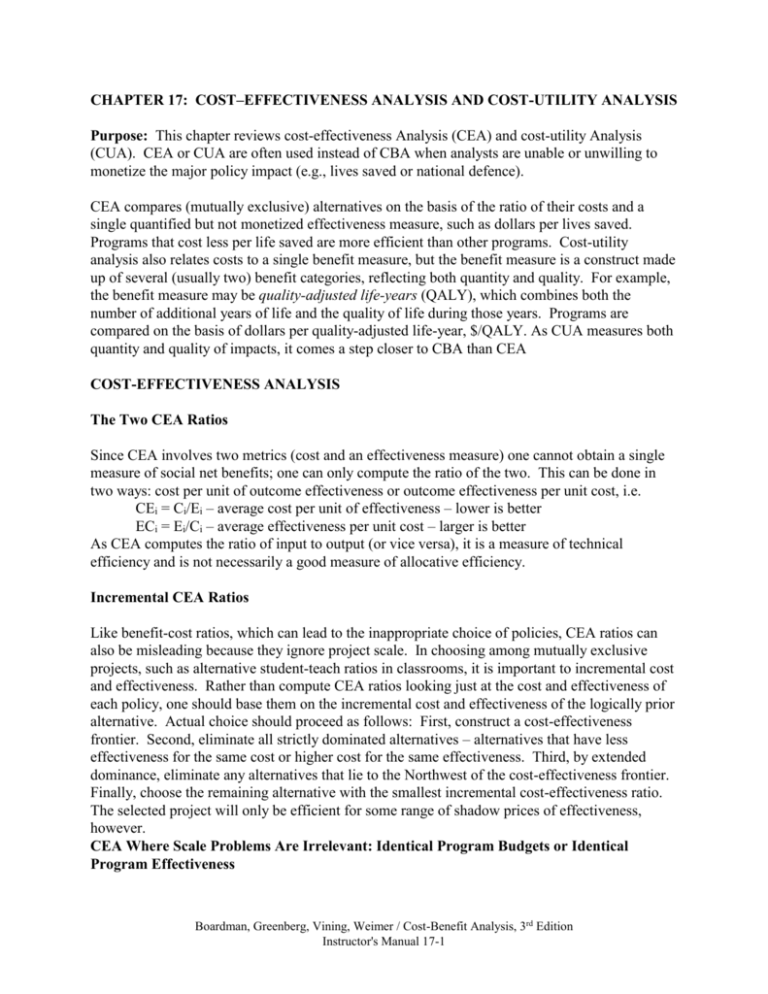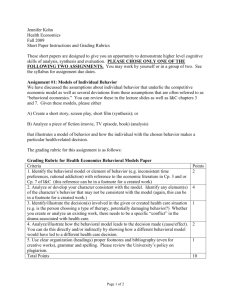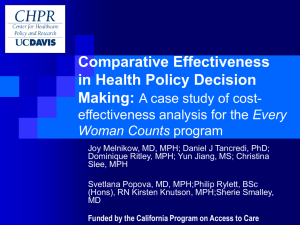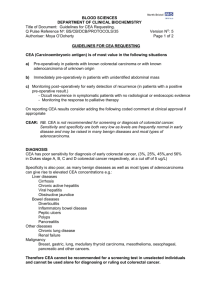cost–effectiveness analysis and cost
advertisement

CHAPTER 17: COST–EFFECTIVENESS ANALYSIS AND COST-UTILITY ANALYSIS Purpose: This chapter reviews cost-effectiveness Analysis (CEA) and cost-utility Analysis (CUA). CEA or CUA are often used instead of CBA when analysts are unable or unwilling to monetize the major policy impact (e.g., lives saved or national defence). CEA compares (mutually exclusive) alternatives on the basis of the ratio of their costs and a single quantified but not monetized effectiveness measure, such as dollars per lives saved. Programs that cost less per life saved are more efficient than other programs. Cost-utility analysis also relates costs to a single benefit measure, but the benefit measure is a construct made up of several (usually two) benefit categories, reflecting both quantity and quality. For example, the benefit measure may be quality-adjusted life-years (QALY), which combines both the number of additional years of life and the quality of life during those years. Programs are compared on the basis of dollars per quality-adjusted life-year, $/QALY. As CUA measures both quantity and quality of impacts, it comes a step closer to CBA than CEA COST-EFFECTIVENESS ANALYSIS The Two CEA Ratios Since CEA involves two metrics (cost and an effectiveness measure) one cannot obtain a single measure of social net benefits; one can only compute the ratio of the two. This can be done in two ways: cost per unit of outcome effectiveness or outcome effectiveness per unit cost, i.e. CEi = Ci/Ei – average cost per unit of effectiveness – lower is better ECi = Ei/Ci – average effectiveness per unit cost – larger is better As CEA computes the ratio of input to output (or vice versa), it is a measure of technical efficiency and is not necessarily a good measure of allocative efficiency. Incremental CEA Ratios Like benefit-cost ratios, which can lead to the inappropriate choice of policies, CEA ratios can also be misleading because they ignore project scale. In choosing among mutually exclusive projects, such as alternative student-teach ratios in classrooms, it is important to incremental cost and effectiveness. Rather than compute CEA ratios looking just at the cost and effectiveness of each policy, one should base them on the incremental cost and effectiveness of the logically prior alternative. Actual choice should proceed as follows: First, construct a cost-effectiveness frontier. Second, eliminate all strictly dominated alternatives – alternatives that have less effectiveness for the same cost or higher cost for the same effectiveness. Third, by extended dominance, eliminate any alternatives that lie to the Northwest of the cost-effectiveness frontier. Finally, choose the remaining alternative with the smallest incremental cost-effectiveness ratio. The selected project will only be efficient for some range of shadow prices of effectiveness, however. CEA Where Scale Problems Are Irrelevant: Identical Program Budgets or Identical Program Effectiveness Boardman, Greenberg, Vining, Weimer / Cost-Benefit Analysis, 3rd Edition Instructor's Manual 17-1 The cost effectiveness ratios in CEAs do not take different scales of projects into account. This is not a problem if all alternatives have the same cost (fixed budget) or if all alternatives have the same level of effectiveness (fixed effectiveness), as shown in Tables 17.1 and 17.2. But if the scales differ, as in Table 17.2, it is not clear which project is best. Although project A has the best CE ratio, one might prefer project B. Imposing Constraints to Deal with Scale Differences In order to use CEA for decision making a common practice is to impose a constraint, either a minimum acceptable level of effectiveness, denoted by E , or a maximum acceptable cost, denoted C . If we impose a minimum level of effectiveness, we may either minimize costs, Ci, or the cost-effectiveness ratio, CEi. If we impose a maximum cost, we could either maximize effectiveness or minimize the cost-effectiveness. An Illustration of the Different CE Rules Table 17.4 provides an illustration of alternative decision-making rules. Even in CEA, decision makers must often make trade-offs between costs and non-monetized benefits to make decisions, implicitly monetizing benefits. Sensitivity Analysis: The Problem of Ratios Special care is required in investigating the sensitivity of CEA ratios to uncertainty in costs and effectiveness because the distribution of the ratio of random variables is often very different from their individual distributions. Even if both costs and effectiveness are normally distributed, there is no guarantee that their ratio will be normally distributed. Indeed, it will usually be skewed. Monte Carlo sensitivity analysis is particularly useful in CEA because it reveals the distribution of the ratio. Measurement of Costs The measurement of costs in CEA varies enormously. In the health care area, costs often, and most narrowly, consist of the cost of medication. More broadly, costs might include other treatment costs, such as the doctors’s time or hospitalization. This is important, for example, in the case of drugs for schizophrenia, which may be expensive but may reduce the time in hospital, which is even more expensive. Even more broadly, costs might also include waiting time or time lost from work, which are borne by patients or employers. Obviously, it is preferable to include all social costs, although costs that are constant across all alternatives can be omitted because this will not change the CE rankings, although it will change the CE ratios. Omitted Impacts: Technical versus Allocative Efficiency CEA almost invariably omits impacts that would be included in CBA. Most CEA studies consider only budgetary costs. Relevant non-budgetary opportunity costs are often omitted. Furthermore, CEA considers only one measure of effectiveness. In practice, however, projects Boardman, Greenberg, Vining, Weimer / Cost-Benefit Analysis, 3rd Edition Instructor's Manual 17-2 often have multiple benefits. For example, regulations that save lives may also reduce injuries or illnesses. Similarly, new drugs may effectively cure a disease and also have fewer side effects than current drugs. To measure allocative efficiency, all costs and benefits should be taken into consideration. One way to get closer to doing this -- that is, to reach a “halfway house” between standard CEA and CBA -- is to compute the following adjusted CE ratio: social costs - other social benefits ~ CE = effectiven ess (17.4) If the numerator can be fully valued and monetized, then this adjusted CE ratio incorporates all the impacts that would be included in a CBA. Because CEA omits important social costs and benefits, it is frequently a poor guide of allocative efficiency. COST-UTILITY ANALYSIS CUA is used most in the area of health care. The measure of effectiveness is usually qualityadjusted life years (QALY). The Meaning of Life – Quality-Adjusted Life-Years, That Is! QALY combines two distinct variables – quality (health status) and quantity (years) of health, as shown in Table 17.5. Formulating a Health Status Index and Measuring QALYs There are four common methods for deriving utility-like measures of health status or QALYs: 1) Health rating method. This derives health ratings from questionnaires with health experts, potential subjects of treatment, or members of society in general. Individuals are asked to assign values between 0 and 1 to various (well-described) health states. 2) Time trade-off method. Respondents asked to compare different combinations of length and quality of life. The trade-offs in the responses provide a basis for ranking various states (in quality and years) 3) Standard gamble method. Respondents are presented with a decision tree with two alternatives like the following: one alternative is impaired health for t years; the other is normal health for n years with probability p or immediate death with probability 1-p. The p at which an individual is indifferent can be interpreted as the respondent’s utility of the former alternative. 4) Health index method. Health status is assessed in terms of a health index with various dimensions of well-being, such as mobility, absence from pain, etc. For example, the Short Form Health Survey (SF-36) provides eight dimensions of assessment. With several levels of well being on each dimension, the index can distinguish among thousands of health status. Researchers use the standard gamble or time trade-off method to elicit respondents’ utilities for a subset of the statuses and then statistically estimate weights that can be used to assign utilities to any of the statuses. Boardman, Greenberg, Vining, Weimer / Cost-Benefit Analysis, 3rd Edition Instructor's Manual 17-3 Some Caveats on CUA Issues related to QALY are not all resolved: Discounting is somewhat problematic as one cannot trade off near years of health for far years of health (and vice versa). Methods are based on questionnaires, so there may be hypotheticality problems (respondents simply haven’t thought about the issues very much), sample selection problems (potential treatment candidates might exaggerate the “utility” they would receive from a better health state following treatment), or framing effects (i.e. how questions are asked) as discussed in Chapter 14. USE OF LEAGUE TABLES CUA and CEA usually compare mutually exclusive projects. League Tables draw upon multiple CUA’s and CEA’s to rank policies sharing the same cost-effectiveness measure, such as cost per life saved. Alternative projects (policies) are usually not mutually exclusive. The major purpose is to highlight policies that are at the extremes– decision makers should do more of those that have very low CE or CUA ratios relative to all other policies, and do less of those that have very high CE or CUA ratios. One should bear in mind, however, that the studies in such tables have different authors, different data and different methodologies: they measure cost differently, omit different costs and benefits, they differ in scale, etc. CONCLUSION: WHEN IS CEA CLOSE TO CBA? CEA measures technical efficiency, not allocative efficiency. The most cost-effective alternative is not necessarily worth doing (i.e. it may not be allocatively efficient). If all social costs are measured, there is only one benefit (effectiveness) and projects are of similar scale, then the rankings by CBA and CEA will be the same. If these conditions do not apply, the analyst could: 1) Try to incorporate significant non-budgetary social costs and other categories of benefits into an adjusted cost-effectiveness measure. 2) Do CBA. 3) Move to a more qualitative evaluation method, such as multi-goal analysis. Boardman, Greenberg, Vining, Weimer / Cost-Benefit Analysis, 3rd Edition Instructor's Manual 17-4






